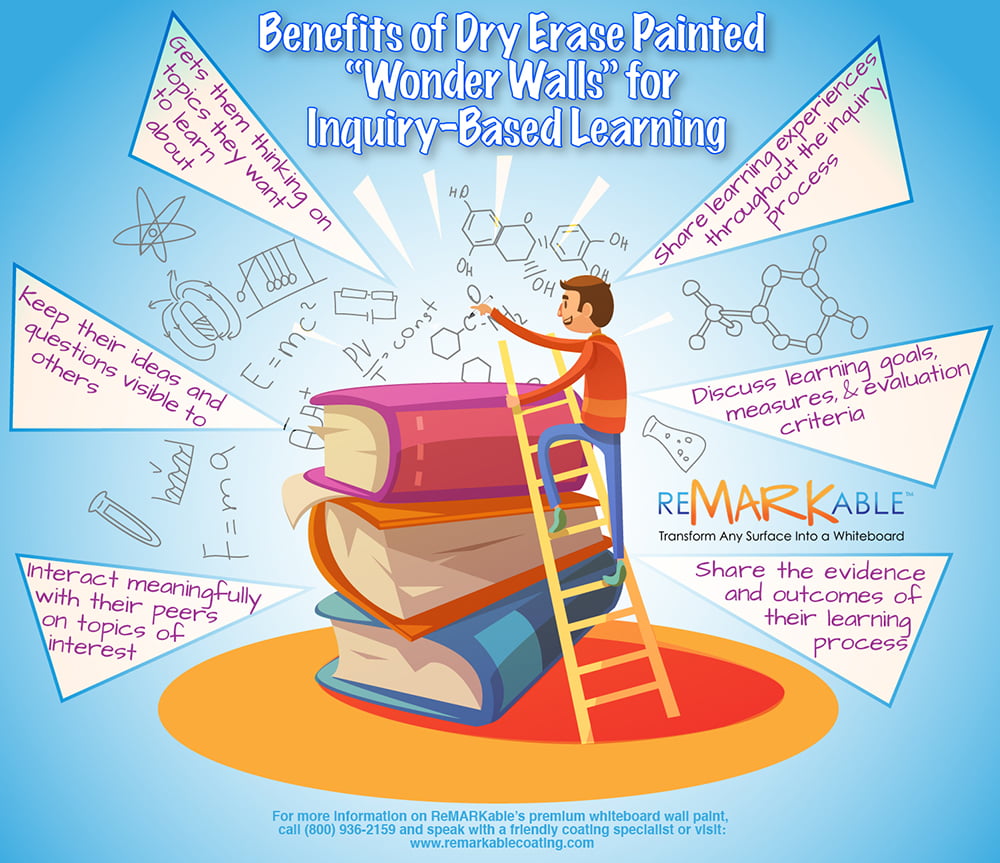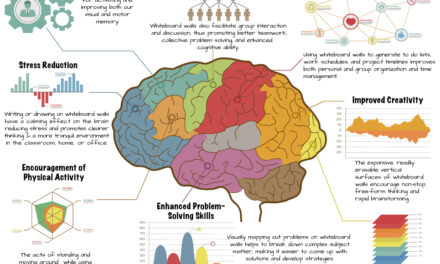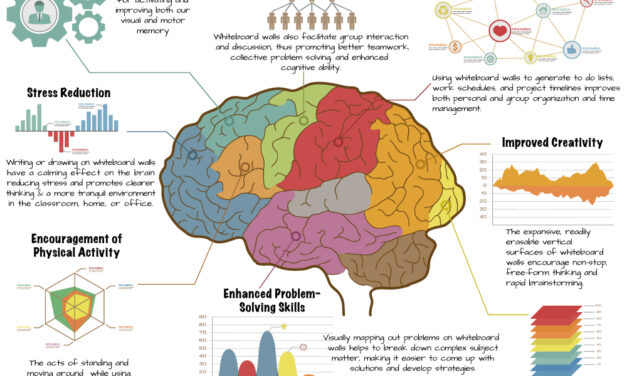Benefits of Dry Erase Painted “Wonder Walls” for Inquiry-Based Learning
Inquiry-based learning is a student-centered instructional strategy that focuses on having students pose and examine questions to gain new knowledge. Occasionally, inquiry-based learning may involve a teacher presenting a problem or scenario for students to explore and address. In all approaches to inquiry-based learning, student questioning and research are at the core of the educational process and dry erase painted walls (aka “wonder walls”) can strengthen that core.
Student inquiries, thoughts, and analyses are emphasized and promoted, with a focus on students’ views about a specific question or issue. This approach is especially effective for creating initial student engagement and then guiding students to go beyond fundamental knowledge to a deeper awareness of critical thinking, evidence-based reasoning, and inventive problem-solving. In inquiry-based learning, students may complete case studies, group projects, or individual research projects, among other tasks. Making in-depth links with the content studied helps students develop skills that will be highly valuable in their future academic lives and worldly careers.
In inquiry-based learning, students come up with questions on their own, seek answers to the questions through research, share their answers and the knowledge they gained, and then reflect on the learning process they experienced. Instead of the teacher always choosing the topic or questions related to a study unit, the students have the freedom to select the questions on the topic they wish to investigate, then pursue their research and present their findings.
Although several types of inquiry-based learning exist, they all have the same outcome. Students make use of open-ended questions to guide their own learning in line with their personal interests; make appropriate connections among details; and thus deepen and broaden their knowledge base and research skills. This approach to education relates to an aphorism by Confucius: “I hear and I forget. I see, and I remember. I do, and I understand.” Inquiry-based learning allows students to genuinely understand the content they study and to increase their wisdom in the process.
What Are the Advantages of Practicing Inquiry-Based Learning on Dry Erase Painted Wonder walls?
The inquiry-based approach to learning arouses students’ curiosity and provides opportunities for collaboration, which in turn increases their engagement and excitement about education. When students feel they have ownership of the learning process, their interest level rises, resulting in a deeper grasp of academic content.
Instead of traditional pedagogy, which is often dominated by teacher talk, teacher questions, memorization, and recall by students, inquiry-based learning supports students in planning and implementing their own educational process. Teachers thus become facilitators, not dictators of instruction. For students of all ages, increased motivation and a genuine love of learning are the outcomes of this method.
Inquiry-based learning is also a great way to provide genuine differentiation; that is, adjusting the pace, level, or type of instruction in response to individual learners’ needs, styles, or personal interests. The inquiry-based approach also helps to build self-reliance and independence and nurtures students’ preferences and pastimes. In addition, recent research shows that inquiry-based learning boosts student achievement levels and evens out the playing field in schools with children of diverse socio-economic backgrounds and cultures. When students are surveyed, they typically say they prefer inquiry-based learning over traditional teaching methods.
The Dry Erase Painted “Wonder Wall”: A Powerful Inquiry-Based Learning Technique
One highly effective strategy for practicing inquiry-based learning is to create a “wonder wall” on your dry erase wall, where students can write “I wonder” types of questions about specific topics with dry erase markers. Here you can also post artifacts to stimulate further questions. Post-it notes can be added to the wonder wall if students come up with additional questions and ideas in class or when they’re outside of the classroom and need a handy way to record their thoughts.
After it’s populated with a sufficient number of artifacts and questions, the wonder wall can become a resource for determining the next topic of study for the class. When generating a wonder wall, teachers should emphasize that all student questions are valid. They should also encourage questions that can’t be answered with a simple “yes” or “no” response but instead lead to in-depth research by students.
Creating a wonder wall is a great strategy to use in inquiry-based learning, as it builds a space where students can do the following:
· Get themselves thinking on topics they want to learn about
· Share their learning experiences throughout the inquiry process
· Keep their ideas and questions visible to others
· Interact meaningfully with their peers on topics of interest
· Discuss learning goals, measures, and evaluation criteria
· Share the evidence and outcomes of their learning process.
Dry erase painted wonder walls are meant to be built at the onset of a unit and should be kept active throughout the unit as they are living representations of students’ learning. Begin building the wall when you first invoke students to start thinking about the topic the class will be studying. Students will examine the artifacts you post on the wall and ask questions about what they’re seeing. This sets the students’ prior knowledge in motion and prompts them to share their ideas with their peers in a knowledge-building cycle.
Artifacts can be Hung on Your Wall with GoodHangups
The artifacts used to trigger student conversations and interest in a topic may include the following:
· physical objects
· photos
· drawings
· copies of internet articles
· videos
· fictional stories
Many teachers like to use pictures printed in color, especially if they don’t have access to real-life objects related to the topic for the unit being covered. Lightweight items such as photos, drawings, and printouts of articles may be posted by using GoodHangups, an innovative new hanging system consisting of a magnetized sticker and a magnet that can be mounted on your dry erase wall without damaging the surface.
The Role of Student Questions is Key to Constructing Your Wonder Wall
The use of a wonder wall at the start of an inquiry unit stimulates students to think about a topic by allowing them to ask questions and providing them with artifacts. The next step is to have the class ask more questions. As mentioned, they can use sticky notes to write down questions about what they see on the wonder wall. Use these notes to help students keep track of what the class is thinking about.
As students continue to share their prior knowledge and questions, the wonder wall is gradually constructed. These questions are the driving force behind the inquiry-based learning process. Arrange the questions according to themes and then use them to come up with goals for learning and criteria for success.
At some point, you’re likely to find gaps in the students’ knowledge that will need to be filled through teacher-directed lessons. Post the questions next to the artifacts on the wonder wall, and throughout the learning process, answer the questions and keep track of those that remain unanswered. It’s through your students’ questions that inquiry-based learning and the wonder wall are developed.
Avoid Answering Questions during the Inquiry Process
While using your wonder wall, if students ask questions, it’s important to avoid giving answers and instead have the students add the questions to the wonder wall and then find the answers by themselves. Leading students through lessons to ultimately give them the answers is not what inquiry-based learning and wonder walls are about. With a wonder wall, students need to work to find information and shouldn’t expect to have an easy way out.
Later on in the unit, you may have discussions about certain topics, and you’ll have to explain various concepts. But you should do this together as a class. In this way, instead of teaching your students, you’re facilitating their learning by providing the tools to find answers on their own.
Through the use of wonder walls, teachers and students enjoy the freedom to build a learning environment that meets the needs of all class members. Thus, inquiry-based learning becomes an effective means to create a place where learners enjoy finding the answers to questions and sharing their knowledge with their peers.


























































































![ReMARKable’s Winter Sale is Here! [25% Off + Free Shipping]](https://www.remarkablecoating.com/wp-content/uploads/2018/01/Red-Tag-Winter-Fashion-Facebook-Post-1-440x264.png)















![Drive Your Organization Into Openness and Watch it Expand [20% Off Whiteboard Paint]](https://www.remarkablecoating.com/wp-content/uploads/2016/04/Drive-Your-Organization-Into-Openness-and-Watch-It-Expand.-1-440x264.jpg)

![30% Off St Patrick’s Day Sale! [Details Inside]](https://www.remarkablecoating.com/wp-content/uploads/2016/03/Glorious-1-440x264.png)


![Giant Leaps Forward Require Big Spaces. [Leap Year Sale Event!]](https://www.remarkablecoating.com/wp-content/uploads/2016/02/Giant-Leaps-ForwardRequire-Big-Spaces-440x264.jpg)

















![ReMARKable Summer Sale 2018 [28% Off Whiteboard Paint]](https://www.remarkablecoating.com/wp-content/uploads/2018/06/Blue-Simple-Line-Beach-Facebook-Post-1-440x264.png)




































































































































































































0 Comments